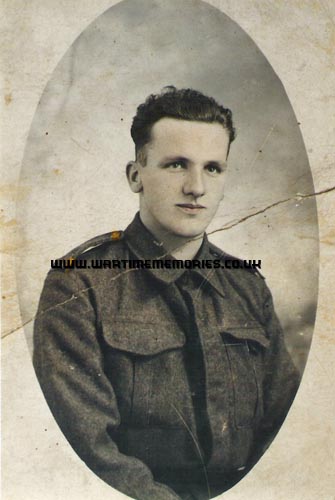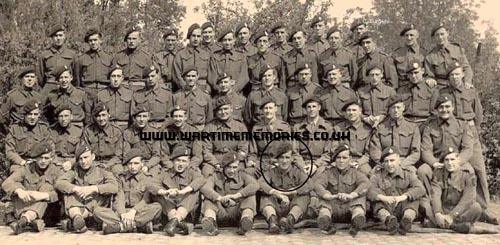|
|
|
No.7 Commando
No. 7 Commando operated as A Battalion in 6th Division. They saw action in Egypt in March 1941 and in Crete during may of that year. In August 1941 they were disbanded with some personnel transfering to Middle East Commando.
If you can provide any additional information, especially on actions and locations at specific dates, please add it here.
|
Those known to have served with No.7 Commando during the Second World War 1939-1945. The names on this list have been submitted by relatives, friends, neighbours and others who wish to remember them, if you have any names to add or any recollections or photos of those listed,
please
Add a Name to this List
Records of No.7 Commando from other sources.
|
|
|
The Wartime Memories Project is the original WW1 and WW2 commemoration website.
Announcements
- The Wartime Memories Project has been running for 24 years. If you would like to support us, a donation, no matter how small, would be much appreciated, annually we need to raise enough funds to pay for our web hosting and admin or this site will vanish from the web.
- 22nd April 2024 - Please note we currently have a huge backlog of submitted material, our volunteers are working through this as quickly as possible and all names, stories and photos will be added to the site. If you have already submitted a story to the site and your UID reference number is higher than 263973 your information is still in the queue, please do not resubmit, we are working through them as quickly as possible.
- Looking for help with Family History Research?
Please read our Family History FAQ's
- The free to access section of The Wartime Memories Project website is run by volunteers and funded by donations from our visitors. If the information here has been helpful or you have enjoyed reaching the stories please conside making a donation, no matter how small, would be much appreciated, annually we need to raise enough funds to pay for our web hosting or this site will vanish from the web.
If you enjoy this site
please consider making a donation.
Want to find out more about your relative's service? Want to know what life was like during the War? Our
Library contains an ever growing number diary entries, personal letters and other documents, most transcribed into plain text. |
|
We are now on Facebook. Like this page to receive our updates.
If you have a general question please post it on our Facebook page.
Wanted: Digital copies of Group photographs, Scrapbooks, Autograph books, photo albums, newspaper clippings, letters, postcards and ephemera relating to WW2. We would like to obtain digital copies of any documents or photographs relating to WW2 you may have at home. If you have any unwanted
photographs, documents or items from the First or Second World War, please do not destroy them.
The Wartime Memories Project will give them a good home and ensure that they are used for educational purposes. Please get in touch for the postal address, do not sent them to our PO Box as packages are not accepted.
World War 1 One ww1 wwII second 1939 1945 battalion
Did you know? We also have a section on The Great War. and a
Timecapsule to preserve stories from other conflicts for future generations.
|
|
Want to know more about No.7 Commando? There are:1318 items tagged No.7 Commando available in our Library There are:1318 items tagged No.7 Commando available in our Library 
These include information on officers, regimental histories, letters, diary entries, personal accounts and information about actions during the Second World War. |
|
Gnr. John Braithwaite 18th Field Regiment Royal Artillery   In 1939, John Braithwaite went to France with the British Expeditionary Force, serving in the Royal Artillery.
In June 1940 s the Germans pushed the BEF back to the coast, he was one who offered to hold the beachhead during the Dunkirk evacuation. When the last troops had been withdrawn, he dived into the surf and being a strong swimmer, struck out towards England. He was rescued by one of the small boats several miles off the French coast, and landed in Margate in the early hours of his 21st birthday.
In July 1940 John was then accepted for 'hazardous duties' and was posted to 23rd Heavy Training Battalion (later renamed No.3 Special Service Battalion). After 6 months tough training, these men became some of the first Commando.
John was posted to No.7 Commando in January 1941 (which merged with 4th Special Service Battalion en route to the Lofoten Islands for the Operation Claymore raid in March 1941, to become No.4 Commando).
No.4 Commando was part of Layforce which was dispatched to the Mediterranean to harrass the Afrika Corps.
John recalled being offloaded from a submarine for the disastrous raid on Bardia in April 1941.
Soon after, the Commandos were sent to defend Crete. They were grossly under-equipped, but fought hard against the overwhelming might of the German paratroopers but, of the 800 commandos sent there, about 600 were listed as killed, missing or wounded. Only 23 officers and 156 ORs escaped.
On the 29th of May 1941 John was evacuated aboard HMS Orion, the cruiser was struck by Stuka bombs, with 260 deaths and 280 wounded. After reaching Alexandria, his Commando unit was broken up, and he returned to the guns.
On the 21st of January 1942, he was injured and captured in Tobruk.
In late 1942, after recovering in a POW hospital in southern Italy, POW No.258058 John Braithwaite was transferred to the Italian-run Campo 52 near Genoa. Conditions were bad and, as supplies grew shorter, the men caught rats and cats to supplement their food. John and several others made an escape from Campo 52 but were recaptured and sent to Campo 70 Monturano (near Parma) and later to Stalag 339 Trieste in northern Italy. As the Allies drew nearer, he was transferred to a work-camp near Dresden called Arb.Komm.855. Later he was moved to Stalag IVB, 30 miles north of Dresden. From here, he escaped with a New Zealander called Arnold Franklin but was caught near the Czech border.
Upon recapture in April 1944, he was put in Stalag IVA at Hohnstein, where he worked in jobs associated with a nearby lignite coalmine.
John stayed in this camp until liberation.
He later emigrated to New Zealand, and served for two years with the RNZ Artillery in Korea, but that's another story.
I would happy to hear from anyone with more details about any of the above. Feel free to contact me.
|
Capt. Jim Staples No 7 Commando My dad Jim Staples was in 7 Comanndo in Crete and North Africa in 1941 and Burma in 1942 until 1945. He was ex-Royal Army Service Corps, serving in 535 petrol company as a corporal and ended the war as a captain. Can anyone give me any information?
|
Henry Thow No. 7 Commando My father Henry Thow was in Stalag 383. He was Scottish and was taken prisoner on Crete after the parachute drop by the Germans. My Dad was in number 7 Commando and were really left to fight the rearguard. He hid out for a while in the mountains but was taken prisoner. The Germans were very bad to them and made them march to the boat to Italy. the men were in cattle trucks and very rarely let out. By the time they reached the camp many had died in the trains.
My Dad said he had been a 'Guest of the Furer' for 5 years! When he came home he was very thin and the last months in the camp was pretty rough as the Germans were not giving them their red cross parcels. He escaped twice and was in solitary often, also for refusing to work on New Years day!! He had a lovley experience when he went back to Crete and was made a honorory member of the local Crete resistance.
|
Recomended Reading.Available at discounted prices.
|
|
|







